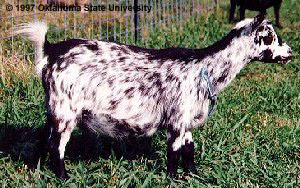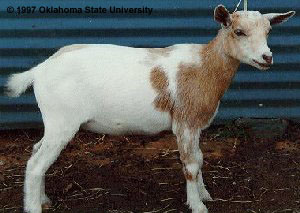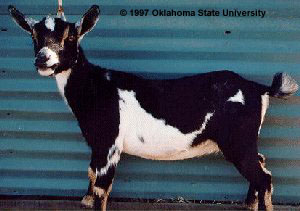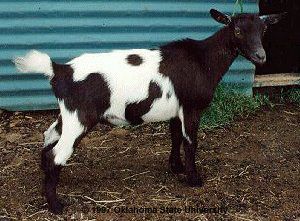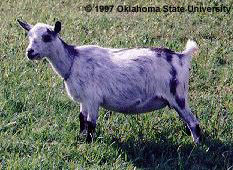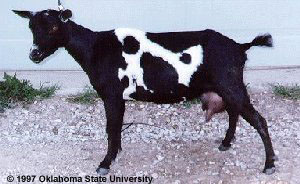Nigerian Dwarf Goats
The Nigerian Dwarf is a miniature goat of West African Origin. Its conformation is similar to that of the larger dairy goat breeds. The parts of the body are in balanced proportion. The nose is straight. The ears are upright. The coat is soft with short to medium hair. Any color or combination of colors is acceptable, though silver agouti (roan) is considered a moderate fault.
Height of the Nigerian Dwarf Goat - (Ideal vs. Maximum)
- Does 17" to 19" 22.6"
- Bucks 19" to 20" 23.6"
Ideal weight is suggested to be about 75 pounds based on HES evaluation information.
Animals are disqualified from the show ring for being over-sized for the breed standard, curly coat,roman nose, and pendulous ears or evidence of myatonia. (This is associated with fainting goats.)
The most commonly asked question about 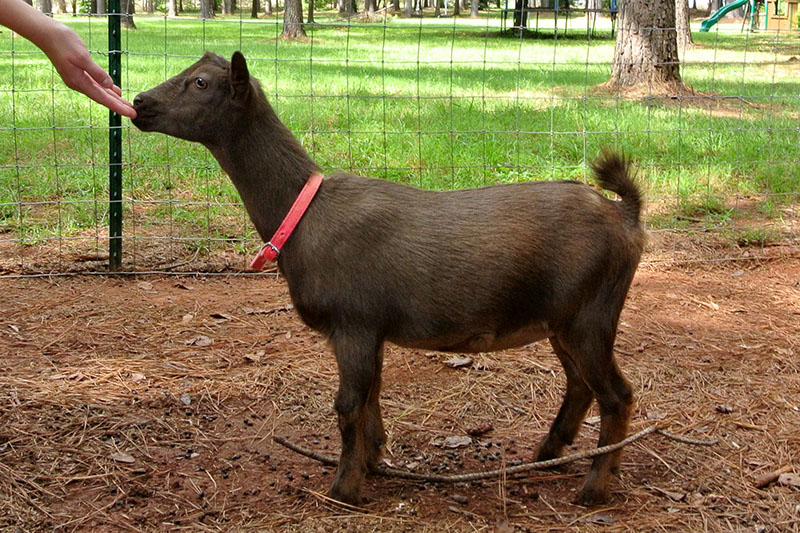 Dwarf goats is: What is the difference between these and Pygmy goats? Although they
have similar origins, they are separate and distinct breeds. Pygmies are bred to be
"cobby" and heavy boned. Dwarves are bred to have the length of body and structure,
in proportion, of a dairy goat.
Dwarf goats is: What is the difference between these and Pygmy goats? Although they
have similar origins, they are separate and distinct breeds. Pygmies are bred to be
"cobby" and heavy boned. Dwarves are bred to have the length of body and structure,
in proportion, of a dairy goat.
Dwarf goats come in many colors. Main color families are black, chocolate and gold. Random white markings are common, as are spots and other color combinations such as red, white, gold and black. Color is one of the BIG factors that makes breeding Dwarves so popular. You never can be sure what color the babies will be until they are born; even then you can't be sure because their color can change.
Dwarf goats are gentle and lovable. Even breeding bucks are handled easily. They make wonderful pets and great animal projects for young children in 4-H.
Breeders of other types of goats find that their Dwarves blend in with the rest of their herd well and do not need special quarters, just adequate fencing to contain them because of their small size.
Dwarf goats breed year round. Many breeders breed their does three times in two years, giving the doe a 6 month plus break. This is of course a personal choice for each breeder.
New born kids average about 2 lbs. at birth but grow quickly. They reach sexual maturity at a young age so be sure and separate the bucks and does. Those little guys have been know to breed and be fertile as young as 7 weeks of age.
Does can be bred at 7 to 8 months of age if they have reached good size. Some breeders prefer to wait until they are at lest 1 year or older.
Dwarf does can have several kids at a time, 3 and 4 being common and sometime even 5. Dwarfs are generally good mothers and able to take care of their babies should you leave them to do the raising of the kids. They can also provide a surprising amount of milk for their size. They can give three to four pounds per day of 6 to 10% butterfat.
Bucks are able to be used for service as young as 3 months of age and easily by the time they are 7 or 8 months old. Dwarf bucks are vigorous breeders but are gentle enough to be used for hand breeding or pasture breeding. Both methods are used successfully.
Dwarf goats are registrable in 3 registries. American Goat Society (AGS), International Dairy Goat Registry (IDGR), and Canadian Goat Society (CGS). Dwarf shows are growing in popularity and becoming more and more available. Most are sanctioned by AGS.
While the Nigerian Dwarf's numbers are still very small (only 3500 animals are registered in the USA with AGS) they have a very bright and profitable future ahead.
Registries and Breed Associations
United States
American Nigerian Dwarf Dairy Association (ANDDA)
President: Ellen Dorsey
21181 E Hwy 28A
Chelsea, OK 74016
Phone: (918) 824-2844
Nigerian Dwarf Goat Association
Denae Steelman
P.O. Box 989 Llano, TX 78643
Phone: (325) 248-5121
e-mail: registrar@ndga.org
References
American Nigerian Dwarf Organization (now disbanded)

